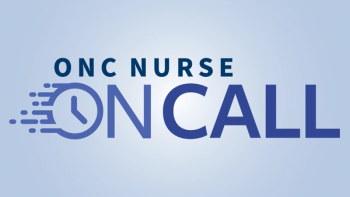
Making Breast Cancer Treatment Decisions After Endocrine Therapy
A breast cancer survivorship expert shares her top advice for counseling patients on endocrine therapy at the 5-year mark.
Providing individualized care and ensuring that patients have access to resources can facilitate conversations around continuing endocrine therapy after 5 years for patients with breast cancer, according to survivorship expert Michelle Kirschner, MSN, RN, ACNP, APRN-BC, the director of program development at the Cancer Survivorship and Supportive Care Professionals Network.
In an interview with Oncology Nursing News, Kirschner explained that, along with a patient’s likelihood to benefit from continued therapy, nurses and advanced practice providers (APPs) should assess the patient’s adverse effect (AE) experience on therapy thus far to take an individualized approach to treatment decisions.
Kirschner explained that the Breast Cancer Index (BCI), a genomic assay, can be used to determine the patient’s likelihood to continue to benefit from therapy. By understanding the patient’s disease and symptoms, nurses and APPs can help patients make informed decisions.
What factors should be considered before deciding whether to continue endocrine therapy after 5 years?
First of all, I want to understand how they’re currently doing on treatment, and if it’s been tolerable. Understanding their AE burden is very important as well as understanding the psychosocial impact of that uncertainty of recurrence. There are individuals that are highly anxious; they want to do everything that they can to feel like they’re helping themselves. I want to fully understand the patient and what’s going on with them, but using our tools that we have to make these decisions is very helpful. [This is because] we’re dealing with uncertainty, and uncertainty is really hard to have.
How can clarity in risk and benefit influence the decision to continue endocrine therapy?
Any time we can be bringing clarity to the situation, it opens up the conversation. For someone who might be anxious about stopping treatment, if we could show them that treatment is not going to benefit them beyond 5 years, then they might be willing to give up treatment. [This compares with] someone who is experiencing side effects, and it’s kind of hard for them, but if you could show them that their treatment is important and is going to have benefit, they might be willing then to just work on lowering their side effect profile but stay on the medication. Methods like these, along with BCI testing, are helpful in bringing clarity into those decisions.
What education should patients receive about long-term and late effects before continuing therapy?
We want to give patients hope, and we can do that by coming alongside them and really wanting to understand what they are experiencing, helping them decrease AEs, but being honest about the long-term effects. We don’t want them to come 5 or 10 years later and say, “You didn’t tell me about this risk.”
Part of this is just educating about, “Ok, these are things that we can help you with. These are things that you don’t have right now, but they might come along. I don’t want to surprise you. I want you to understand that, and that needs to be part of the decision that’s being made.”
We know that there are long-term and late effects that can occur. It’s one of the things that’s important: to always be monitoring and looking for them. The thing that’s important is that we have a plan to support those AEs. It’s not enough to say somebody has fatigue, but we know that exercise is magical in reducing fatigue. Part of that is the obligation of the cancer programs, providers, and staff to come alongside patients and make sure they have a good plan in place.
There are some known long-term effects that you can’t avoid, such as osteoporosis and other types of sexual health issues that you can help with, but they will be there because of the impact of these longer-term hormonal blockades.
How should clinicians handle situations where their professional opinion differs from the patient’s preference?
The idea of patient-centered care is so important. That means that you look at that individual and try to understand: what is important to them, what is their mission, and what do they want? If you allow that conversation, and you see that individual as a whole person with a family and interests and things, then you start to understand that your professional opinion is 1 component of this decision but understanding from the other individual what’s important to them can sway you.
We give our best input, but ultimately, we should always allow the patient to make those decisions. Any cancer treatment has AEs. Our goal is to minimize AEs, but treatment has a toll, and it can be in multiple ways. It’s having to decide the risk vs benefit ratio, and with each person it’s so individualized.
How should nurses explain the benefits and limitations of BCI testing?
What’s most important is to let patients know when we have these types of tools to use in decision making, because there are so many times that patients don’t even know these resources are available. It’s also a part of the patient’s decision if they want to use BCI.
The first step is that education and ask: “What is this? Why is it important? How is it useful?” Then they need to decide, “Is that something that I want to do?” If you’re new to the space, you must feel comfortable with having that discussion. That’s what’s important—being able to fully educate the patient as to why [the BCI] could be helpful in their decision making on both ends [of the spectrum]. Maybe it’s convincing someone who’s having a hard time on these medications to continue, giving them that motivation factor, but it also may be allowing individuals who don’t need to continue treatment to feel confident stopping treatment and relieving some of their anxiety. Having that discussion and being able to do the pros and cons [is helpful for patients.]
This transcript has been edited for clarity and conciseness.
Newsletter
Knowledge is power. Don’t miss the most recent breakthroughs in cancer care.




